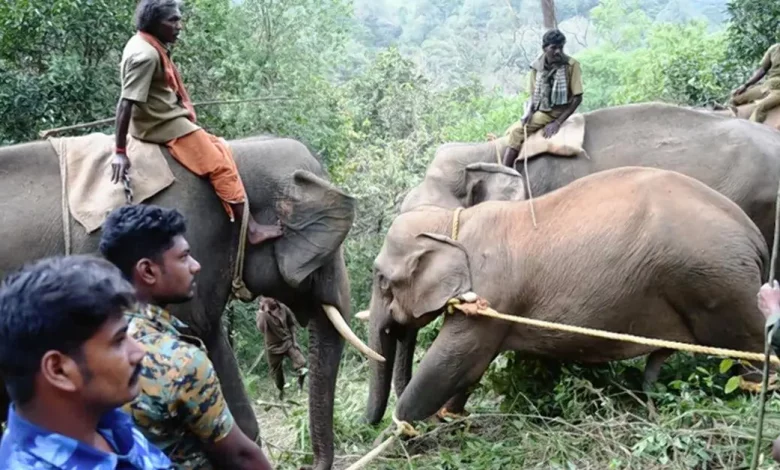Human Animal Conflict
Syllabus: Environment & Conservation[GS Paper-3]

Context: Wayanad is on the boil after a wild elephant chased a 47-year-old man and trampled him to death.
Key points of the news:
- The recent tragedy highlights the increasing conflict between humans and animals in the state.
- There have been more incidents of wild animals, such as elephants, tigers, bison, and wild boars, attacking humans.
- Government data shows that in 2022-23, there were 8,873 wild animal attacks, with elephants being responsible for the majority.
- These attacks not only pose a risk to humans but also harm the agriculture sector, leading to crop loss and the death of domestic animals.
- Wayanad, a region with a significant forest cover, has been heavily affected by elephant and tiger attacks over the past decade.
Why is human-wildlife conflict on the rise?
- As the rate of the global human population and the pressure for more housing continue to grow so is the space between humans and wildlife.
- This coexistence with humans all too often leads to raised rivalry and, as a result, the rise of contests for limited resources, and finally the conflicts between humans and wildlife.
- Besides many other threats, the present Demand of human space versus wildlife has been the most important factor in the disappearance of many large animal population, and is now a risk of extinction for their survival as well.
- While this conflict undoubtedly casts a short-term shadow of negative consequences on the residents and wildlife in and around the vicinity of the conflict area, the problem of human-wildlife conflict is far more complex and extends far beyond that.
- The fact that the wildlife conflict above is about the interaction between people and wild animals means that it is directly tied and cohesive with the initiatives related with the sustainable development goal.
- If not diagnosed properly and appropriately human-wildlife conflict could become a very serious problem that could extend way beyond the current pool of activities or conservation efforts on a much bigger scale.
Who is impacted by human-wildlife conflict and in what ways?
- Human – wildlife conflict is a multiplicity that has negative repercussions with the wildlife as well as the neighbourhood.
- Such conflict can cause decreases in species populations and can even lead to extinction. Communities around the area may experience financial losses due to damaged property as well as loss of their main source of income.
- They may also suffer health risks and threats to their way of life i.e. livelihood, food supply and property.
- Although the homeless population has to cope with wildlife, the strain and difficulties revert to the poor and marginalised communities where the defence mechanisms and the opportunities for self-improvement are limited.
- At the same time associated with the reach of wildlife benefiting other living organisms and the ecosystems that support our life by providing food, employment or any other means we normally use to accomplish our daily tasks.
- Although the struggle between people and wildlife may have conservation as one its most significant considerations, it is also a moral and social issue.
- It reduces their welfare, living conditions, and those used to earn living from agriculture such as farmers, herders, and artisanal fishers who are mostly poor.
- However this also has an impact worldwide, negatively affecting agricultural production and global supply, therefore pushing people into food insecurity and reduced production rates.
Why are current strategies not fully sufficient to address human-wildlife conflict?
- The strategies and solutions currently in place are insufficient for addressing the extent of the problem.
- Management measures are often implemented in a fragmented way, with a primary focus on conservation.
- Additionally, there is a lack of coordinated and sufficient support from other sectors and organisations that are affected, despite the global nature of the issue.
What solutions are there to help humans and wildlife coexist and how do they benefit all involved?
- As our world becomes more crowded, human-wildlife conflict is inevitable.
- However, with effective management strategies and integrated approaches, we can reduce and minimise conflict in the long term.
- These strategies not only benefit biodiversity and impacted communities but also society, sustainable development, production, and the global economy.
- It is important for global cooperation and resources to be dedicated to addressing this issue on a large scale.
- To achieve coexistence, we need to reassess the relationship between people and wildlife and find solutions that address the underlying causes of conflict.
- The case studies in this report show that coexistence is possible and achievable.
Future Prospective:
The state is implementing various measures to address human-animal conflict.
- This includes installing early warning systems to track dangerous animals, planting indigenous plants to ensure their food security, and converting agricultural land into forestland.
- Rapid Response Teams have also been established in areas with high conflict rates.
- Additionally, the state is running schemes for the construction of barriers and electric fencing to protect against elephants.
Source: IE
Practice Questions:
Q. Examine the reasons for rising incidents of human wildlife Conflict. Suggest some possible measures to tackle this problem of modern age.





.png)



